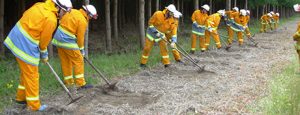The Green Triangle Forests Industries Hub wants improved coordination and deployment of cross border fire resources in a step to enhance fire protection and suppression activities in the Green Triangle. Source: Timberbiz
With the current fire season coming to an end last week, Green Triangle Forest Industries Hub executive general manager Liz McKinnon highlighted that an estimated 40,000 hectares of land across the Limestone Coast and south west of Victoria had been impacted, including the loss of 1250 hectares of plantation estate valued at more than $18 million.
She said cross-border fire events, such as the 900-hectare Kentbruck forest blaze near Nelson, had illustrated the need for a uniform communication system, reducing the confusion of sharing state, volunteer and company-based radio channels.
“Border fire events this season reiterated the need to have greater cross border harmonisation, streamlining policies and procedures to dispel confusion on the fire line,” Ms McKinnon said.
“There are instances where some units are carrying up to five different radios at border fire events to keep in touch with each of the appliances movements to ensure they are armed with the latest information. There is absolutely no unity in radio communication which increases safety and coordination challenges for all involved which is simply unacceptable.”
The Hub’s submission to the SA bush fire inquiry has urged the State Government to investigate introducing a singular, fire training and accreditation model, such as the CFA Forest Industry Brigade (FIB) system to support the forestry sectors 230 fire trained personnel.
The Green Triangle Fire Alliance, supported by the long-standing Forest Owners Conference, has been formed in an effort to generate greater coordination of resources in both states, streamlining policies and procedures with a focus on improved fire management outcomes.
Alliance chair Laurie Hein said local foresters were currently paying for staff to undertake both CFS and CFA training which had limited synergy, promoting its own distinct certification, policies and procedures.
“There is strong evidence to support a national accreditation and training model to allow strike teams to confidently and efficiently respond to any fire event, whether it’s in the Green Triangle or any state or territory knowing they are property equipped and accredited,” he said.
“There is widespread support for the extension of the CFA Forest Industry Brigade model which has a distinct training focus on fighting plantation fires, which is a very different practice to a structure or grass fire event.
“Under the current CFS model, personnel are being trained on attending an array of emergencies including such things as car accidents and structural fires, which has little relevance to plantation fires and in some cases requires specialist breathing apparatus.
“The implementation of the CFA FIB model in South Australia would overcome these training issues, stopping repetition of training models and ensure our community and assets have even greater protection.”
Mr Hein said this cross-border management strategy extended to aerial appliances, which must work seamlessly and respond efficiently in either state for the full extent of the fire season.
He said while six aircraft were committed to protecting the region, there had been delays in responding to some local fire events.
“There have also been instances during high fire danger days last season that the two fire bombers which are to protect the Limestone Coast region were parked in Adelaide, forced to travel up to 500km in a fire event,” he said.
“The Kentbruck fire was a clear illustration of the necessity of having firefighting aerial capacity at hand to respond immediately. There is a view that if bombers had been available and dispatched in the initial stages of that fire it could have possibly been quickly contained, potentially saving hundreds of hectares of plantation and reducing the threat to neighbouring communities and landowners.”






